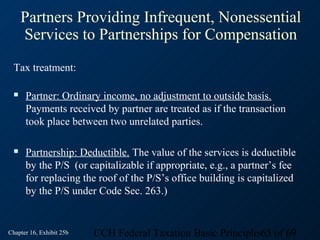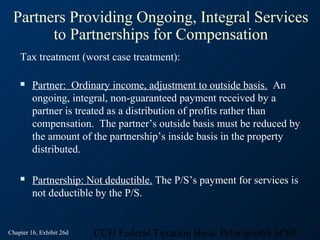This document provides an overview of key topics related to partnerships covered in Chapter 16, including:
1) The definition of a partnership as an unincorporated association with two or more persons who associate for profit.
2) Partnerships are generally treated as pass-through entities where income/loss and separately stated items are allocated to partners.
3) Separately stated items such as capital gains/losses must be stated separately since tax treatment may vary between partners.
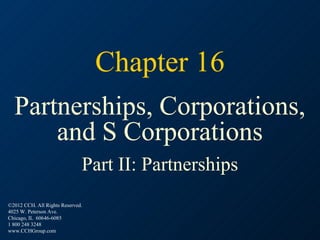



![Types of Partnerships
General partnership [GP]. A GP has one or more general partners
who is personally liable for partnership debts; a general partner can
be bankrupted by a malpractice judgment brought against the
partnership, even though the partner was not personally involved in
the malpractice.
Limited liability partnership [LLP]. An LLP is similar to a general
partnership, except that an LLP partner is not liable for any
malpractice committed by the other LLP partners.
Chapter 16, Exhibit 2a CCH Federal Taxation Basic Principles5 of 69](https://image.slidesharecdn.com/2013cchbasicprinciplesch16pii-120911125342-phpapp02/85/2013-cch-basic-principles-ch16-pii-5-320.jpg)
![Types of Partnerships
Limited partnership [LP]. An LP is comprised of at least one general
partner and often many limited partners. Limited partners may not
participate in the management of the LP, and their risks of loss are
restricted to their equity investments in the LP.
Limited liability company [“LLC”]. An LLC is a state-registered
association generally taxed as a partnership if it “checks the box.”
LLC members, like corporate shareholders, are not personally
liable. Unlike limited partners, LLC members may participate in
management without risking personal liability. However,
guaranteed payments are subject to self-employment tax, along with
the members’ share of ordinary income or loss from the LLC.
Chapter 16, Exhibit 2b CCH Federal Taxation Basic Principles6 of 69](https://image.slidesharecdn.com/2013cchbasicprinciplesch16pii-120911125342-phpapp02/85/2013-cch-basic-principles-ch16-pii-6-320.jpg)
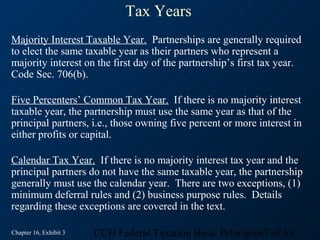

![Tax Formula
[Taxation at Owner Level]
Ordinary Income “From Whatever Source Derived”
(including Code Sec. 1245 recapture)
– Exclusions and Cost of Goods Sold
= Gross Income from Business Operations
- Operating Expenses
– Code Sec. 702(a)(8) Ordinary Income
+ or - Separately Stated Items (These are items that may result in
different tax treatment by different partners. Examples include
capital gain or loss and charitable contributions.)
Chapter 16, Exhibit 5 CCH Federal Taxation Basic Principles9 of 69](https://image.slidesharecdn.com/2013cchbasicprinciplesch16pii-120911125342-phpapp02/85/2013-cch-basic-principles-ch16-pii-9-320.jpg)

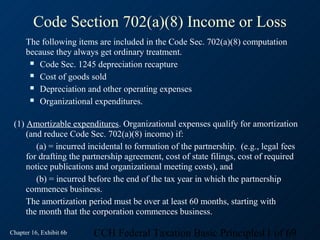








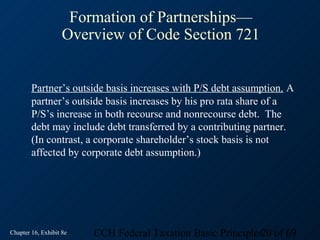



![Formation of Partnerships—
Overview of Code Section 721
What is “property”?
“Property” includes just about everything except services. (i.e.,
cash, inventory, receivables, land, other tangible assets,
nonexclusive licenses and industry know-how.)
[Note: Since neither Congress nor the Treasury Dept. have offered
a definition of property, the courts have been guided by analogous
interpretations under Code Sec. 351. Recall that Code Sec. 351
provides for nonrecognition treatment on the transfer of “property”
to an 80% controlled corporation in exchange for stock.]
Chapter 16, Exhibit 8i CCH Federal Taxation Basic Principles24 of 69](https://image.slidesharecdn.com/2013cchbasicprinciplesch16pii-120911125342-phpapp02/85/2013-cch-basic-principles-ch16-pii-24-320.jpg)
![Formation of Partnerships—
Overview of Code Section 721
Why are “services” NOT “property’?
Reg. §1.721-1(b)(1) provides that services are NOT property to ensure
that a person who provides services to a partnership will be taxed either:
1. Immediately, on the FMV of the P/S capital interest received:
With a contribution of services, the FMV of the P/S capital interest
received is taxed to the partner as compensation (i.e., OI). [Recall that a
shareholder’s contribution of services gets similar ordinary treatment.]
2. Eventually, on the receipt of income from an income only P/S
interest:
If services are performed in exchange for an income interest, (not a
capital interest), then income recognition is DEFERRED until income is
received. The reason for deferring the recognition of income is because
of the difficulty in determining a market value of the speculative future
profits.
Chapter 16, Exhibit 8j CCH Federal Taxation Basic Principles25 of 69](https://image.slidesharecdn.com/2013cchbasicprinciplesch16pii-120911125342-phpapp02/85/2013-cch-basic-principles-ch16-pii-25-320.jpg)

![Part Property/ Part Services—Example
FACTS
“A” transfers the following items to XYZ Partnership in exchange for a capital
interest:
Asset FMV Basis
Land $50,000 $10,000
Services $35,000 $0
QUESTION: How much income is recognized on the transfer?
SOLUTION
Services: $35,000 OI as compensation.
Land: $0. The $40,000 [50,000 - 10,000 = 40,000] realized gain on transfer of
land is NOT recognized, consistent with Code Sec. 721; rather, it is a built-in
gain.
Chapter 16, Exhibit 10 CCH Federal Taxation Basic Principles27 of 69](https://image.slidesharecdn.com/2013cchbasicprinciplesch16pii-120911125342-phpapp02/85/2013-cch-basic-principles-ch16-pii-27-320.jpg)

![Disguised Sales—General Rules
The P/S sold the distributed property to an unrelated 3rd party.
Gains or losses are recognized by partners and
partnerships on disguised sales, based on the difference between
fair market value (FMV) and adjusted basis (AB). However,
recognition of losses depends on the partner’s % ownership
interest. If the partner has a “ > 50% capital interest,” NEITHER
may recognized losses. Instead, the related party rules must be
applied. Code Sec. 707(b)(1).
[Compare these rules with the rules for corporations. C
corporations recognize gain but NEVER LOSS on transfers of
nonstock property to any shareholder, regardless of ownership
%.]
Chapter 16, Exhibit 11b CCH Federal Taxation Basic Principles29 of 69](https://image.slidesharecdn.com/2013cchbasicprinciplesch16pii-120911125342-phpapp02/85/2013-cch-basic-principles-ch16-pii-29-320.jpg)
![Disguised Sales—General Rules
If a disguised sale involves the transfer by a partnership of a
capital interest, does part of the transaction qualify for Code Sec.
721 nonrecognition treatment? If so, how much?
Yes, % of total transfers that get Code Sec. 721 nonrecognition
treatment, are: [(a) – (b)] ÷ (a), where:
(a) = FMV of property contributed by the partner to the P/S; and
(b) = FMV of property other than a capital interest distributed by
the P/S to the partner.
Chapter 16, Exhibit 11c CCH Federal Taxation Basic Principles30 of 69](https://image.slidesharecdn.com/2013cchbasicprinciplesch16pii-120911125342-phpapp02/85/2013-cch-basic-principles-ch16-pii-30-320.jpg)
![Disguised Sales—Example
FACTS: Fred transfers land [$400 fair market value (FMV),
$120 adjusted basis (AB), held long-term for investment
purposes] to a partnership (P/S) in exchange for:
1. A capital interest worth $100;
2. $300 cash.
QUESTIONS:
A. What portion of the exchange represents a disguised sale?
B. What portion of the exchange represents a Code Sec. 721
contribution?
C. What is the tax treatment to Fred?
D. What is the tax treatment to P/S?
Chapter 16, Exhibit 12a CCH Federal Taxation Basic Principles31 of 69](https://image.slidesharecdn.com/2013cchbasicprinciplesch16pii-120911125342-phpapp02/85/2013-cch-basic-principles-ch16-pii-31-320.jpg)
![Disguised Sales—Example
SOLUTION
The transfer is treated as a partial disguised sale and a partial partnership contribution:
Total Disguised Sale (75%): Contribution (25%):
FMV of cap. int. 100 75 25
Cash 300 225 75
Amount realized 400 300 100
Basis in land 120 90 [75%] 30 [25%]
Realized gain 280 210 70
Recognized gain 210 0
Character of gain LTCG Not recognized
Computation 100% - 25% = 75% (400 - 300) ÷ 400) = 25%
Reason for tax Reg. §1.707-3(a) Code Sec. 721
treatment: Recognition of realized gain Nonrecognition on transfer of
from disguised sale. property for a P/S interest.
Chapter 16, Exhibit 12b CCH Federal Taxation Basic Principles32 of 69](https://image.slidesharecdn.com/2013cchbasicprinciplesch16pii-120911125342-phpapp02/85/2013-cch-basic-principles-ch16-pii-32-320.jpg)
![Disguised Sales—Example
SOLUTION
Fred’s basis in the partnership interest: $30 [25% of the basis of
land is attributable to a “contribution.”
P/S’ basis in the land: $330 [Fred’s 30 basis of land
“contributed” + 300 “sale” price.]
COMMENTS
Even if Fred had received the $300 cash 2 years after receipt of a
P/S interest, the IRS would still presume that Fred’s contribution
was partially a disguised sale as per above. Fred would have to
prove otherwise.
Chapter 16, Exhibit 12c CCH Federal Taxation Basic Principles33 of 69](https://image.slidesharecdn.com/2013cchbasicprinciplesch16pii-120911125342-phpapp02/85/2013-cch-basic-principles-ch16-pii-33-320.jpg)
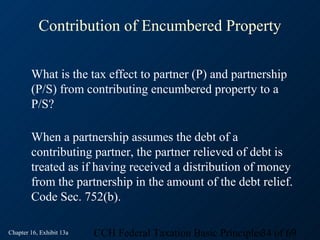


![Contribution of Encumbered Property—Example
FACTS:
Ann, Bob and Cal decide to pool their efforts and form a partnership. They make the
following contributions to the partnership:
C
Partner FMV AB to P P’s % int. in P/S:
ontribution
Ann Services $ 30,000 $ 0 30%
Bob Land 70,000 20,000 60%
Cal Equipment 10,000 11,000 10%
TOTALS $110,000 100%
Bob’s land is subject to a $10,000 mortgage that the partnership assumes.
The FMV of the P/S is $100,000 [$110,000 FMV assets - $10,000 debt assumed.]
Does this transfer of assets qualify for Code Sec. 721 treatment?
What is each partner’s gain or loss on contributions to the partnership?
What is the resulting basis of each partner in the P/S (“outside basis”)?
What is the P/S’s basis in the assets received (“inside basis”)?
Chapter 16, Exhibit 14a CCH Federal Taxation Basic Principles37 of 69](https://image.slidesharecdn.com/2013cchbasicprinciplesch16pii-120911125342-phpapp02/85/2013-cch-basic-principles-ch16-pii-37-320.jpg)










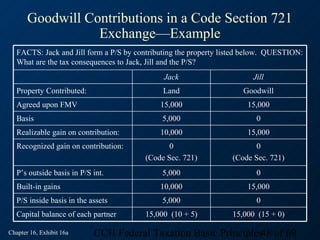
![Goodwill Contributions in a Code Section 721
Exchange—Example
SOLUTION:
If both Jack and Jill were to sell their partnership interests for $15,000 each,
assuming no other transactions, the partnership would have no distributive gain,
[since post-contribution-date values do not change] but Jack and Jill would
recognize their respective built-in gains:
Jack: $10,000 capital gain [15,000 FMV at contribution -
5,000 basis at contribution]
Jill: $15,000 capital gain [15,000 FMV at contribution - 0
basis at contribution].
Chapter 16, Exhibit 16b CCH Federal Taxation Basic Principles49 of 69](https://image.slidesharecdn.com/2013cchbasicprinciplesch16pii-120911125342-phpapp02/85/2013-cch-basic-principles-ch16-pii-49-320.jpg)


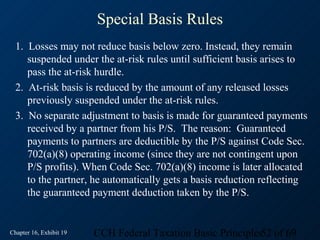
![What Is a Partner’s Holding Period (HP) in the
Outside Basis?
The HP depends on the type of property contributed by the partner:
Type of Contribution HP of Partnership Interest
Investment or business property Tacks on to property contributed.
Other property (e.g., receivables and Begins on day after contribution.
inventory)
Services Begins on day after contribution.
[Note that an outside basis can have a split holding period if multiple assets are
contributed.]
Chapter 16, Exhibit 20 CCH Federal Taxation Basic Principles53 of 69](https://image.slidesharecdn.com/2013cchbasicprinciplesch16pii-120911125342-phpapp02/85/2013-cch-basic-principles-ch16-pii-53-320.jpg)


![Outside Basis Computations—Example
(A): $25,000 [10,000 capital account + (1/2 x 30,000 P/S debt)]
(B): $41,275 [see below]
(C): $29,275 [see below]
+ MARY’S BEGINNING BASIS (A)
+ Share of P/S’s TI under Sec. 702(a)(8) 24,000 =[1/2 x 48,000]
+ Share of “separately stated items” 5,275 =[1/2 x (5 + 6.2 + .5 - .1 - .25 - .8)]
– Share of debt relief (3,000) =[1/2 x (30,000 - 24,000)]
– Basis of land distributions to Mary (10,000) = [100% x 10,000]
MARY’S ENDING BASIS (B) 41,275
MARY’S ENDING CAPITAL ACCT 29,275 =[41,275 - (1/2 x 24,000 debt]
BAL. (C)
Note: The Code Sec. 1245 gain was a “smoke screen” because it is already included in Code Sec.
702(a)(8) taxable income. Recall that Code Sec. 1245 gain gets ordinary treatment and is not part of
the netting process. With its “automatic” ordinary treatment, there is no need for it to be “separately
stated.” Doing so in this problem would have resulted in its being counted twice.
Chapter 16, Exhibit 21c CCH Federal Taxation Basic Principles56 of 69](https://image.slidesharecdn.com/2013cchbasicprinciplesch16pii-120911125342-phpapp02/85/2013-cch-basic-principles-ch16-pii-56-320.jpg)


![Code Section 465 At-Risk Rules
(d) What about alimony paid, charitable contributions and
other nonbusiness/noninvestment expenses? Prop. Reg.
§1.465-13 addresses this question by providing that,
“ ...allowable deductions allocable to an [passive] activity are
those otherwise allowable deductions incurred in a trade or
business or for the production of income from the activity.”
(In other words, alimony and charitable contributions paid by a
partnership are generally NOT subject to the at-risk rules since
they do not ordinarily serve a business or investment purpose to
the passive activity incurring these expenses. However, facts
and circumstances govern “purpose”.)
Chapter 16, Exhibit 22c CCH Federal Taxation Basic Principles59 of 69](https://image.slidesharecdn.com/2013cchbasicprinciplesch16pii-120911125342-phpapp02/85/2013-cch-basic-principles-ch16-pii-59-320.jpg)
![Code Section 469 Passive Activity Loss Rules
As with the at-risk rules, the passive activity loss (PAL) rules are
applied on a partner-by-partner basis, not at the partnership level.
However, unlike the at-risk rules, the PAL rules apply only to
business income and losses [i.e., Code Sec. 702(a)(8) taxable
income or loss.] PALs are deductible (i.e., allowed to “jump Hurdle
2”) to the extent of Code Sec. 702(a)(8) income from all passive
activities in the aggregate.
“Portfolio income” (interest, dividends, annuities, royalties not
derived from the ordinary course of business and gains or losses
from assets that produce such income, less related expenses) shall
not be considered as arising from a passive activity. Code Sec.
469(e)(1).
Partnership ordinary loss is generally passive to a partner unless the
partner materially participates in the partnership activity.
Chapter 16, Exhibit 23 CCH Federal Taxation Basic Principles60 of 69](https://image.slidesharecdn.com/2013cchbasicprinciplesch16pii-120911125342-phpapp02/85/2013-cch-basic-principles-ch16-pii-60-320.jpg)

![At-Risk and Passive Activity Loss Rules—Example
At-Risk Hurdle (H1)
Yr Beg. At- Passive Passive Contrib. Amt. of Loss “Jumping” H1 Loss “Blocked” By
Risk Basis Income (Loss) (Distr.) H1
(a) = (i) (b) (c) (d) (e) = (f) =
from prior Lesser of: [(c) + (f) from prior
yr. period] - (e)
[(c) + (f) from prior yr.] or
[(a)+(b)+/-(d)], expressed as a
negative number.
x1 24 (25) 0 (24) (1)
Lesser of: (25) + 0 - (24) = (1)
[(25) + 0 = (25)]; or neg. [24 + 0
+ /- 0] = (24); Lesser = (24).
x2 0 3 0 (3) (21)
Lesser of: 0 + (24) - (3) = (21)
[0 + (24) = (24)]; or neg. [0 + 3 + /-
0] = (2); Lesser = (2).
Chapter 16, Exhibit 24b CCH Federal Taxation Basic Principles62 of 69](https://image.slidesharecdn.com/2013cchbasicprinciplesch16pii-120911125342-phpapp02/85/2013-cch-basic-principles-ch16-pii-62-320.jpg)
![At-Risk and Passive Activity Loss Rules—Example
Passive Hurdle (H2)
Yr Amt. of Loss Loss “Blocked” Ending At-Risk Income Deduct
“Jumping” H2 By H2 Basis
(g) = (h) = (i) = (j) = (k) = (g)
Lesser of: [(e) + (h) from (a) + (b) +/- (d) + (b) from all
[(e) + (h) from prior prior period] - (e) passive activities
yr.]; or (g)
[(b) from all passive
activities, expressed
as a neg. number.
x1 0 (24) 0 0
[(24) + 0 - 0 = [24 + 0 + 0 + (24) (b) = 0 (g) = 0
(24)] = 0]
x2 (3) (24) 0 3 (3)
[(3) + (24) = (27]; [(3) + (24) - (3) [0 + 3 + 0 + (2) =
neg. 3 = (3); = (24)] 0]
Lesser = (3)
Chapter 16, Exhibit 24c CCH Federal Taxation Basic Principles63 of 69](https://image.slidesharecdn.com/2013cchbasicprinciplesch16pii-120911125342-phpapp02/85/2013-cch-basic-principles-ch16-pii-63-320.jpg)
![Partners Providing Infrequent, Nonessential
Services to Partnerships for Compensation
What rules govern transactions between partners and
partnerships (P/Ss)?
Infrequent, nonessential services. Code Sec. 707(a)(1) allows
nonpartner status when a partner acts in an independent
capacity, rendering services that are neither ongoing nor
integral to the operations of the partnership. [For example, a
partner who is a licensed CPA prepares the partnership’s tax
returns for his customary fee.] Code Sec. 707(a)(1)
encompasses both “outbound” (partnership pays partner) and
“inbound” (partner pays partnership) payments. The payments
may be for services, interest on loans, leases or purchase of
property.
Chapter 16, Exhibit 25a CCH Federal Taxation Basic Principles64 of 69](https://image.slidesharecdn.com/2013cchbasicprinciplesch16pii-120911125342-phpapp02/85/2013-cch-basic-principles-ch16-pii-64-320.jpg)
